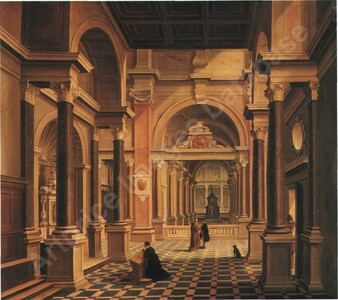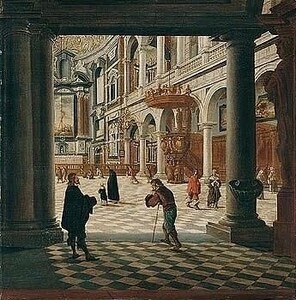5.500 €
Circle of Bartholomeus van Bassen
(Possibly born in Antwerp circa 1590 – 1652 The Hague)
An unusual architectural phantasy
Oil on panel : 68,3 X 55,8 cm
Illegible faded signature top middle
Dated in the stone cartouches under the statues of Caritas and Justitia
“Anno” and “1647”
Frame : 84,3 X 70,6 cm
About Bartholomeus van Bassen
Dutch painter
Possibly born in Antwerp circa 1590 – 1652 The Hague
Painter of architectural scenes and architect.
It is not known whom van Bassen studied with.
He was actually the first Dutch painter to specialise in the genre of architectural painting.
Van Bassen is first recorded in Delft in October 1613, when he was accepted as a master painter in the local guild. It was then specified that he was not an inhabitant from Delft, so that he had to pay a higher fee. It is not known where exactly he was born.
Some sources suggest he came from Antwerp, as his two earliest known paintings, dated 1614 (Sotheby’s New York 27/01/05) and 1616 (our painting) both represent the interior of a Catholic, Flemish, Gothic church decorated with altars and populated with figures. In their accomplished single-point perspectival construction, in their treatment of light and in the carefully rendered details both paintings do indeed show the influence of the Flemish perspective painters Hendrick van Steenwijck I and II of Pieter Neeffs I. Both these church interiors have in the past been said to represent (possibly) the Cathedral of Antwerp; both must for sure have been strongly inspired by it.
Throughout his career van Bassen specialised in imaginary architectural spaces of church interiors and lavishly decorated palace interiors.
Our painter joined the guild at The Hague in 1622 and remained there until his death thirty years later. The Hague offered, as the residence of the Stadtholder and of the States of Holland, the possibility of richer patrons.
A church interior from 1624 (Berlin, Gemäldegalerie) was co-signed by van Bassen and the Antwerp figure painter Frans Francken II. According to Marijke de Kinkelder this is no further proof of his Antwerp origin; it might well be that the client whom the painting was made for wanted this specific artist to paint the staffage. This painting belonged by 1632 to the collection of Stadtholder Frederick Henry.
Van Bassen was also active as an architect:
- at the end of the 1620s he drew the plans for the Royal house in Rhenen for Frederick, the exiled Elector Palatine and the so-called Winter King of Bohemia; he was a nephew of Stadtholder Frederick Henry;
- he made designs for the construction of several palaces for the Stadtholder, such as Huis Honselaarsdijk and Huis ter Nieuburch;
- in 1634 he drew plans for the restoration of the town hall of Arnhem;
- from 1638 onwards van Bassen served as the town architect and controller of the building sites and of the worksmen at The Hague. In fact The Hague remained officially a village until 1811 when it received the title of town. He built some twenty bridges, restored its town hall and supervised the construction of the New Church (the first church of The Hague specially built for Protestants) after the design of Pieter Noorwits.
Bartholomeus’ only son, Aernout Ernst, did not become a painter; he was a lawyer at the Court of Holland. He married a daughter of the Utrecht painter Cornelis van Poelenburch in 1651.
Why should you buy this painting?
Because it is such an original, unique subject.
Comparative paintings
Click photos for more details


